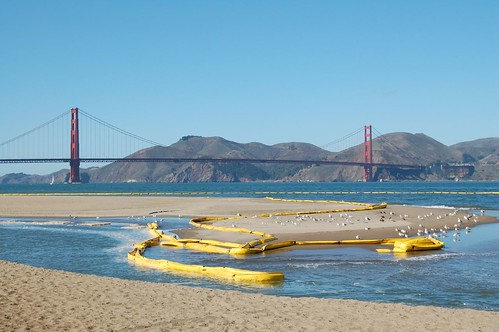 Oil booms at Crissy Field. Credit: fredsharplesJust two days before a container ship hit the Bay Bridge, spilling 58,000 gallons of oil into the waters of San Francisco Bay, QUEST web producer Craig Rosa and I were at Crissy Field beach. We were photographing pelicans and recording dogs playing in the sand for an upcoming Exploration. When I went to the beach Thursday morning, there was a big lump in my throat as I watched those same pelicans skim the water that wasn’t the same as it had been the morning before.
Oil booms at Crissy Field. Credit: fredsharplesJust two days before a container ship hit the Bay Bridge, spilling 58,000 gallons of oil into the waters of San Francisco Bay, QUEST web producer Craig Rosa and I were at Crissy Field beach. We were photographing pelicans and recording dogs playing in the sand for an upcoming Exploration. When I went to the beach Thursday morning, there was a big lump in my throat as I watched those same pelicans skim the water that wasn’t the same as it had been the morning before.
It seems that the fate of birds in these situations provokes an especially emotional response in most people. Maybe it’s their visibility, maybe it’s the metaphor of losing flight, but there’s something about an oil-covered bird that makes plain the most tragic consequences of human interactions with nature.
Standing at the beach (which I visit frequently because it’s across from my office) made me realize how much there is to understand about the Bay’s inner workings. Knowing that there was much less oil on Crissy Field than at Rodeo Beach made me consider how the Bay’s currents flow than I had before. The booms floating in the water prompted questions about whether marine microorganisms are filtered out along with the oil, what role such critters play, and how they’re faring in an oily environment. Watching ducks splash about in the marsh, I wondered about the less-visible fates of the plants and fish below the surface. No doubt the oil spill's effects are beyond birds and oily blobs on the beach, hidden to those of us unfamiliar with the Bay’s ecosystems and mechanics.
While Craig and I meandered the dunes with Park Service staff days before, we learned that Crissy Field is an ever-changing environment, always in flux, sometimes through forces of nature and sometime at the hands of humans. Remembering this was heartening. Crissy Field has gone from natural shoreline to air strip and back to shoreline again, and has recovered from past oil spills much larger than this one. Nature (with a little help from concerned citizens) has amazing repair mechanisms, and has allowed Crissy Field to survive many assaults during its history. Despite its current scars, it will survive this as well.
![]() Robin Marks is a journalist and science writer who current serves as a Multimedia Projects Developer for the Exploratorium in San Francisco, CA.
Robin Marks is a journalist and science writer who current serves as a Multimedia Projects Developer for the Exploratorium in San Francisco, CA.
